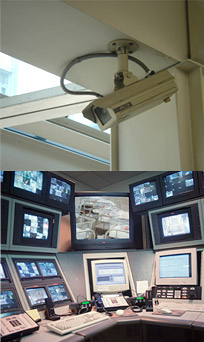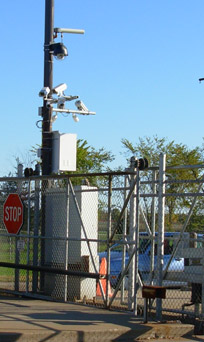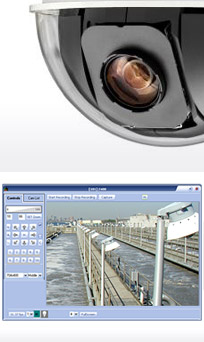
 DETEXI® Network Video Management System DETEXI® Network Video Management SystemEXPAND YOUR CONCEPTS OF SECURITY |
 |
 |
| Javascript Tree Menu | |
|
|
|
|
|
— Component Considerations – Video Management Software — Overview —
Video Management Software
 Video management software is an important component of an IP-Surveillance system because it effectively manages video for live monitoring and recording.
Video management software is an important component of an IP-Surveillance system because it effectively manages video for live monitoring and recording.Video management requirements differ depending on the number of cameras, performance requirements, platform preferences, scalability, and the ability to integrate with other systems. For advanced recording and event management, video management software serves as the core of professional video surveillance systems.
 The software is installed on a PC and can be an independent solution or a client/server-based application for multiple simultaneous users. The software is installed on a PC and can be an independent solution or a client/server-based application for multiple simultaneous users.  From the software interface, operators can, for example, record video continuously, on schedule, on alarm and/or on motion detection or search for recorded events. From the software interface, operators can, for example, record video continuously, on schedule, on alarm and/or on motion detection or search for recorded events.
— Component Considerations — Video Management Software — Common Features —
Common Features
 There are common features in almost every video management software, no matter the type or size: There are common features in almost every video management software, no matter the type or size:
Simultaneous viewing and recording of live video from multiple cameras —
Video management enables multiple users to view several different cameras at the same time, and allow recordings to take place simultaneously. Video management software can also increase the resolution for cameras with activity or alarms.
Several recording modes —
Continuous, on alarm and/or video motion detection, and scheduled (which can combine continuous and on alarm recording instructions).
Alarm management functions —
Parameters can be established so that alarms are not sent during hours of normal activity — for example, such as from 8 am to 9 pm, Monday through Friday. Therefore, if motion is detected at 3 am on a Saturday, the system knows that this activity is not normal — starts recording and can send e-mails or text messages to alert the proper authorities.
Frame rate control —
Video management enables users to set the recording frame rate of selected cameras, and pre-determine that if activity is detected, the recording frame rate would increase, and if there is no motion, the rate would decrease.
Camera management —
Video management systems allow users to administer and manage cameras from a single interface. This is useful for tasks such as detecting cameras on the network, managing IP addresses, and setting resolution, compression and security levels.
Audio support —
Some video management software may also include full duplex, real-time audio support, as well as analytical tools that improve image details or provide helpful information to users.
— Component Considerations — Video Management Software — Platform / Advantages —
Platform / Advantages

Platform
Video management software can be installed on a PC server platform. Most video management systems are available for the Windows operating system, but there are also options for UNIX, Linux and Mac OS. Open platform solutions run on off-the-shelf hardware, with components selected for maximum performance.
Scalability
The systems are fully scalable because cameras can be added one at a time, and there is no limit to the number that can be added or managed.
Web interface
Some video management systems use a web interface to access the video from any type of computer platform. Web interfaces allow video to be managed online from anywhere in the world, using the proper safeguards such as password protection and IP address filtering.
Integration
Video management systems based on open platforms have another advantage in that they can be more easily integrated with access control devices, building management systems, industrial control systems and audio. This allows users to manage video and other building controls through a single program and interface.
Video management systems also enable video to be integrated into industrial automation systems or BMS, such as heating, ventilation, and air conditioning systems. To do this, digital inputs and outputs (I/O) provide data to the system or the network cameras for functionalities such as controlling the heating or lighting in a room when it is not in use.
— Component Considerations – Video Management Software — DETEXI Software
DETEXI Network Video Management System
 An example of a video management software is the DETEXI Network Video Management System. DETEXI System is specially designed to manage network cameras and video encoders to provide multi-camera viewing, high-quality recording, alarm notification, multi-view playback and remote access capabilities.
An example of a video management software is the DETEXI Network Video Management System. DETEXI System is specially designed to manage network cameras and video encoders to provide multi-camera viewing, high-quality recording, alarm notification, multi-view playback and remote access capabilities.
Platform
The DETEXI Video Management System runs as a background service on a Windows PC with XP Professional, 2000 or 2003 Server. This means that even when you’re logged off the PC that is running the software, the DETEXI System is still operating.
Scalability
The DETEXI Network Video Management system is fully scalable. A base license is required to run the DETEXI Video Management System and allows for a specified number of cameras to be used with the program. Additional camera licenses, as well as software upgrade licenses, are available for purchase. Cameras and licenses can be added one by one and the system hardware can be expanded to meet increased performance requirements. There is no limit to the number of cameras that can be added or managed.
Distributed NVR Network — DETEXI NVR Domain
DETEXI security installation has the ability to scale from small business use to enterprise level security operations.With a number of cameras sending information over a long period of time, the only way to deal adequately with the shear volume of files is to share the load over a distributed NVR network. NVR network consists of several NVRs that are logically attached to the main NVR — DETEXI NVR Domain Controller. The DETEXI NVR Domain Controller is the core component for multi-site connectivity —
it is indispensable solution for complex distributed environments and monitoring centers.  Thus, it is possible to control several NVRs remotely from the NVR Domain Controller. Thus, it is possible to control several NVRs remotely from the NVR Domain Controller. Each particular NVR is responsible for its group of cameras and carries the task of recording, touring and alarming functions. Each particular NVR is responsible for its group of cameras and carries the task of recording, touring and alarming functions.  NVR Domain Controller learns everything about the NVR’s in the NVR network and their group of cameras. NVR Domain Controller learns everything about the NVR’s in the NVR network and their group of cameras.
Integration
The DETEXI Network Video Management system as an open platform system has another advantage in that it can be more easily integrated with access control devices, building management systems, industrial control systems and audio. This allows users to manage video and other building controls through a single program and interface. Integrating a video surveillance system with access control systems allows video to be captured at all entrance and exit points.
|